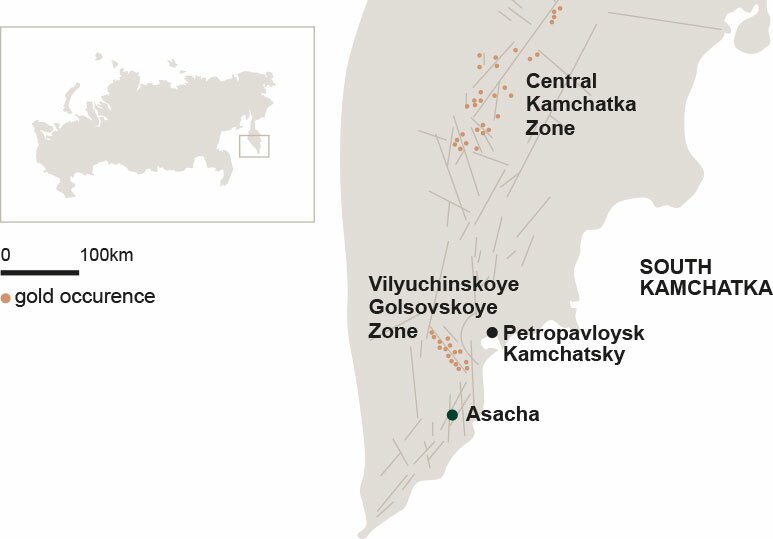Overview
- Established gold mine in Far East Russia
- High grade underground operation
- Production: 36,714oz for FY17
- Low Cash Cost operation: US$588/oz*
*FY 2017. Cash costs are calculated on consolidated basis and include all costs absorbed into cost of sales, excluding mining tax, depreciation, amortisation and depletion, net of by-product revenue (silver).
Location
The Asacha Gold Mine is located in Kamchatka in Far East Russia.
The Asacha Gold Mine is some 150 kilometres to the south of the port of Petropavlovsk - Kamchatsky, the regional capital.
Access to the mine site is by wheeled vehicle of which the first 90 km of the road is mostly paved, being the road to the Mutnovskaya geothermal power station. The remaining 60 km is along an unpaved all-weather road which has been constructed by the Company.
The Company has helicopter landing facilities at the mine.

Mine development
Bringing the Asacha Gold Mine into Production
2003 |
VNIPI Feasibility Study |
2005-2007 |
Metallurgical Test-work |
2005 |
Environmental Impact Assessment |
2006 |
Environmental Management Plan |
2008 |
Development mining commenced Business Plan and Capital Cost Update |
2011 |
Gold production commenced |
Geology
Regional geology
Kamchatka forms part of the Pacific 'Ring of Fire', a volcanically and seismically active zone that rings the Pacific Ocean. The peninsular is formed from a number of superimposed volcanic arcs, some of which are still active, that have been generated since the Tertiary age. The arcs are orientated north-northeast along the axis of the peninsular and are delineated by linear alignments of volcanoes and valleys.
The presence of active volcanoes, geothermal springs and regular seismic events indicates that this activity is ongoing. Such geological conditions are conductive to the formation of epithermal style gold/silver deposits and are recognised as making the Pacific Rim geologically attractive to exploration companies looking for epithermal gold mineralisation.
A large number of gold occurrences have been identified in Kamchatka, the majority of which occur in two distinct zones. The Vilyuchinskoye-Golsovskoye Zone, a northwest-southeast trending zone of gold occurrences, is of most importance in the context of Asacha and has been interpreted to be a result of regional scale rifting forming dilational structures between two strike-slip faults.
Such dilational structures are recognised as being conducive to the formation of hydrothermal vein deposits such as at Asacha.
Deposit geology
The Asacha deposit occurs within either a caldera structure or the remains of a large eroded volcano. Younger ash deposits that limit the exposure of the older rocks now overlie much of the area surrounding the deposit. The deposit consists of a number of north-south orientated parallel veins emplaced into the surrounding country rocks.
The country rocks have been subdivided into a suite of volcanics and a number of sub-volcanic intrusions. The volcanics consist of a variety of tuffs that are permeable and incompetent in nature and are therefore not susceptible to brittle deformation and subsequent vein deposition. The sub-volcanic intrusions consist of a number of dacitic to andesitic domes and sills that are competent in nature and subject to brittle deformation and vein formation.
A number of structural trends have been identified in the Asacha project area. Two regional northeast trending structures are present, the most northerly of which crosscuts the veins without any discernable deformation. These are therefore interpreted as pre-mineralisation regional features. A series of east-west trending structures are present which are also interpreted to be pre-mineralisation features. Some post-mineralisation movement, however, may have resulted in some displacement of the mineralised veins. The veins themselves are hosted in north-south trending structure corridors. A series of northwest trending structures has resulted in a number of mineralised offshoots and splays from the main veins. Notwithstanding the apparent structural complexity of the area, the veins containing the bulk of the resource are essentially undeformed in nature and continuous along strike.
The Company has classified the gold-silver mineralisation at Asacha as a low sulphidation adularia- sericite epithermal type quartz veins, such as those found in a number of localities along the margins of the Pacific Ocean. Two principal vein systems have been identified: the Main Vein system; and the lesser-explored Eastern Vein system. The majority of the identified resources occur in the Main Vein. The Main Vein at depth consists of a north-south striking vein dipping steeply to the east. Closer to surface, this vein splits into a number of subsidiary veins including some zones of stockwork. The Eastern Zone consists of a number of minor north-south trending steeply dipping veins.
The veins at Asacha are banded in nature with alternating bands of quartz and dark sulphidic material. The majority of the gold mineralisation occurs within the sulphidic bands, with lesser amounts in the surrounding quartz. Ore shoots have been identified in the veins and are interpreted as being a function of the interaction between the northwest trending structures and the veins, resulting in dilational zones.

